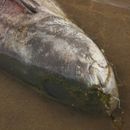Diagnostic Description
provided by Fishbase
Distinguished from all other freshwater fishes in Europe by the following unique characters: two pairs of mental barbels; and anal fin with 83-91½ rays. Differs further from the following combination of features: body naked; large, depressed head; dorsal fin with 2-4½ rays; caudal fin rounded or truncate; no adipose fin; and anal rays almost touching caudal (Ref. 59043). Caudal fin with 17 rays (Ref. 2196).
Diseases and Parasites
provided by Fishbase
SVC. Viral diseases
Life Cycle
provided by Fishbase
Males defend small territories in the spawning sites and construct nests made of plant materials. They dig shallow depressions or clean spawning substrate such as willow (Salix) and roots. Males guard the nests until larvae emerge. Spawns in pairs. Eggs hatch in 2-3 days. Larvae live in the nest until yolk sac is absorbed for 2-4 (Ref. 59043). Eggs are surrounded by a mucous and adherent wrapping. Incubation lasts about 50 hours at 24°C. Egg size 3 mm, larval length at hatching 8.5 mm (Ref. 26211).
Morphology
provided by Fishbase
Dorsal spines (total): 1; Dorsal soft rays (total): 4 - 5; Analspines: 1; Analsoft rays: 83 - 95
Trophic Strategy
provided by Fishbase
Found in deep waters of dams constructed in the lower reaches of rivers (Ref. 9696).
Biology
provided by Fishbase
The maximum length of the species has been recorded as 5 m for a long time and the maximum weight as 306 kg . It has been demonstatred that misidentifications and problems of measurment units have led to these numbers. The recorded maxima with evidence are 2.73 m and 130 kg (Ref. 123627). Inhabits large and medium size lowland rivers, backwaters and well vegetated lakes (Ref. 59043). Occurs mainly in large lakes and rivers, though occasionally enters brackish water in the Baltic and Black Seas (Ref. 9988). Found in deep waters of dams constructed on the lower reaches of rivers (Ref. 9696). A nocturnal predator, foraging near bottom and in water column. Larvae and juveniles are benthic, feeding on a wide variety of invertebrates and fish. Adults prey on fish and other aquatic vertebrates. Attains first sexual maturity at 2-3 years of age (Ref. 59043). Spawns in the salt water of the Aral Sea (at Kulandy) (Ref. 1441). Marketed fresh, canned and frozen; can be pan-fried and baked (Ref. 9988). Locally threatened due to river regulation destroying shallow spawning sites (Ref. 59043).
Importance
provided by Fishbase
fisheries: commercial; aquaculture: commercial; gamefish: yes

